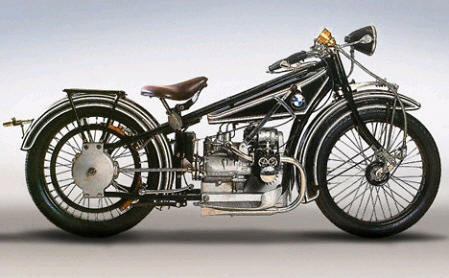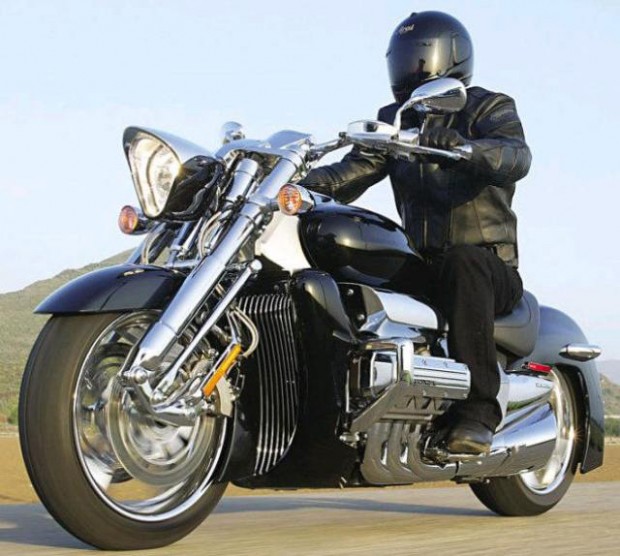HISTORY OF THE FRONT END – PART IV
THE TRAILING LINK FORK
Indian were one of the first motorcycle manufacturers in the world. They had to grapple with the problem of providing suspension to their motorcycles early in the piece, and they came up with the trailing link fork.
Indian persevered with this idea for decades.
A 2006 US postage stamp celebrates the 1940 Indian Four, a luxury superbike with a pair of forks terminating in pivots for the two short links which hold the front wheel. These pivots extend backwards from the fork to the wheel mounting, but also forwards from the fork to join with a U-shaped arm which connects to a leaf spring jutting out from the bottom of the steering head.

The 1940 Indian Four: 1265cc of USA luxury
Earlier versions of Indian’s front end had spawned a notable imitator.
Under the terms of the Versailles Treaty at the end of World War I, Germany was forced to abandon its air force. This was bad news for the aircraft engine manufacturer Bayerische Motoren Werke AG, and they desperately looked for alternative products to manufacture. They tried agricultural implements, furniture, and toolboxes; and then decided to turn their engine building skills to motorcycles. Their first motorcycle, the Flink, went on the market in 1920.
It was not a success.
In 1921, they put their second model, the Helios, to market. It didn’t sell well, either.
These two models were placeholders while BMW’s chief engineer Max Friz got his piéce de résistance ready for market.

BMW’s R32: their first sales success
The 1923 R32 had a 494cc flat-twin two-cylinder side-valve ‘boxer’ engine, an exposed driveshaft final drive, and a three-speed transmission. It had no front brake, but it had a big disk on the rear wheel, and pressing the brake pedal pushed wooden blocks against it. The chassis had a rigid tubular-frame with sprung seat, and it had trailing link cantilever suspension, just like the big company in America made.
BMW manufactured the R32 for three years, selling over 1,000 a year on the average; no mean feat in the hyper-inflated mess that was the economy of post-war Germany’s Weimar Republic.
Trailing link forks seemed to die with Indian, but they re-appeared recently on a power cruiser manufactured by, surprisingly, Honda.
The Honda Rune has a large pair of forks which look as though they telescope but, in fact, don’t. The forks terminate in pivots for the trailing arms, at the end of which is the front axle. Halfway along the trailing arms, they are connected to a U-shaped arm which conveys movement to the suspension – a pair of shock/spring assemblies mounted up near the steering head.
It separates suspension and braking forces, which many believe is a Good Thing.

The Honda Rune: trailing link in the 21st century
It looks trick, but it provides less than 100mm of suspension travel – about 30% less than most street bikes. But then, how much suspension travel do you need to ride on freeways?
The other way of adding suspension to the lower end of a set of forks was to let the wheel lead, rather than trail, the fork.
With the advent of one-piece spring/damper units, the leading link fork became a reasonable alternative. One of the most famous racing motorcycles of all time, the Moto Guzzi V8, had leading link forks. The spring/damper units were mounted close and parallel to the forks. A triangular bracket welded to the rear of the fork mounted the pivot for the links.
The Guzzi 500 V8 never went for long enough for someone to complain about its handling. It had the usual limited travel of leading link forks, but it tended to race on nice smooth tracks, so it didn’t matter a lot.

The 1957 Guzzi V8 GP racer: leading link front suspension
A few years later, one of the biggest selling motorcycles of all time sported a leading link setup, too: the Honda 50 step-through. And my own first motorcycle, purchased in bits at the age of fifteen, had leading link forks and was a Honda as well: the 305cc C77 (the engine was used as a template by Laverda to build their first 750 twin).
At the time I bought my C77, I was not old enough to ride on the road. It made a poor bush-basher.
The trouble with leading link (and indeed trailing link) is that the links are independent. Look at the picture of the Guzzi. If the springs are slightly mismatched, the front wheel will twist during suspension travel and go out of alignment to the rear wheel.
This problem was recognised many years earlier, and solved by an English engineer called Ernest Earles. His solution was to make a rigid swingarm to hold the front wheel. In order to make it rigid, it had to be pivoted BEHIND the wheel, so the fork bent back at a severe angle.
BMW caught on to Earles’s design, abandoned the engineering abomination of telescopic forks, and started fitting Earles forks to the front of their machines in 1955.

The Earles fork: strong yet heavy, but the natural anti-dive made up for a lot
While heavy in terms of the reciprocating mass of the entire front end, the Earles fork was reasonably rigid and the unsprung weight was reasonably low. It still had a large front end to twist a small steering head, but it also had natural anti-dive built into the geometry. The swingarm was pointed slightly down – under brakes the motorcycle would try to go over the top of it and it would extend the suspension rather than compressing it. This was good for BMW riders, as their engines stuck out the side a long way, and would hit the ground if you applied the brakes while leaned over.
Earles’s design had the other advantage that suspension travel could be quite long with minimal variation in wheelbase.
In 1961 Husqvarna entered several bikes in the Coupe d’Europe. Their leading link-forked model came fourth. Their tele-forked model came first.
BMW discontinued Earles forks after 1970, as fashion dictated the return of the telescopic fork. The last blast for leading link forks was during the 1970s, and was mostly on dirt bikes. There was a small Spanish bike called El Gato, a few Greeves’, a Hagglund military motorcycle, a CZ 125. A Zundapp, from memory, as well.

Husqvarna’s 4th place winner in the 1961 Coupe d’Europe
In racing, they didn’t acquit themselves exceptionally badly. Neither did they acquit themselves exceptionally well.
And they just went out of fashion. Telescopic forks were easier to style, and while the brakes got in the way of steering and suspension, teles had been around since the 1930s. Over the years some pretty good engineers had applied themselves to the telescopic fork’s shortcomings. And a well designed telescopic fork made to close tolerances, mounted in a strong frame and looked after could provide formidable performance.
The next big development in suspension wouldn’t come until the late 1970s. And it wouldn’t be picked up by a big manufacturer for another thirty years.









